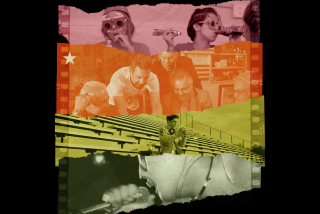For All Its Gains, the Chicano Movement Is Still Struggling Uphill : Latinos: After 20 years, the firebrands of <i> el movimiento </i> are sobered by the obstacles that persist in the struggle for equality.
- Share via
Hundreds of Chicanos will gather Thursday in a “20th-Year Activist Reunion” in San Antonio, Tex., to reassess the gains of el movimiento, the Chicano movement. As we walk down Memory Lane, bidding farewell to the commercially dubbed “Decade of the Hispanic,” we will ask ourselves, “As a community, are we better off now than we were 20 years ago?”
Organized by Chicano veterans of community, labor and anti-war struggles, our meeting will analyze the accomplishments and shortcomings of the mass movement we helped unleash and organize.
In the 1960s, as farm workers raised pickets, as students organized strikes and as anti-war activists developed the Chicano Moratorium, most of us never imagined that a multifaceted social movement was brewing. It was a movement not unlike that of African Americans, but it was unique to our own culture and history. Thus, our demands for equality and an end to racism were accompanied by demands for bilingual education and the return of land to the descendants of original land-grant holders. Our identity was redefined in the process: transforming working-class, barrio youth into Chicanos, proud of our mestizo roots.
The reunion promises to be a fun affair, with menudo breakfasts, Norteno dances, and even 3-K races. Undoubtedly, we will swap time-warped war stories and poke fun at how we young fighters of the ‘60s now have paunches or bifocals or bald spots and slower moves on the dance floor.
Present will be some of the major architects of the movement, people whose names can now be read in the fledgling academic accounts about this period. They may not be widely known, but they laid the foundation for gains we have made and may perhaps be personally enjoying. We will honor those still with us, like Emma Tenayuca, who organized and led the great pecan-shellers’ strike in Texas in the ‘30s, and Reyes Lopez Tijerina, who spent years in prison for his work in the land-grant struggle in New Mexico in the ‘60s. We will remember our dead, like Willie Velasquez, who founded the Southwest Voter Registration and Education Project in the ‘70s, and whose successful challenges to politically disfranchising electoral systems have begun to eliminate racist barriers to the election of Chicanos to office.
We will applaud the important, if limited, gains in entertainment, art, music, sports and politics. But while we fought for these, they were not all we had in mind. Twenty years ago when we wrote our manifestoes calling for Chicano liberation--or at least, social, economic and political equality--our success was to be gauged by the degree to which we, as an entire community, emerged from poverty and second-class citizenship. The result so far is not encouraging.
Key social and economic indicators show that Chicanos, as a community, have not advanced significantly in 20 years; in some respects we’ve even stagnated. This year, Chicanos are more likely to be poor than we were 10 years ago. More than one-quarter of our families, almost one-quarter of our elderly and one-third of our children live below the poverty line today. Since 1970, the earnings of Latino males have declined from 90% to 78% of what white men with equal training earn. Yet government support for affirmative-action programs has been virtually dismantled.
While some of us will gather at the reunion as Ph.D. s, attorneys or physicians, in terms of education, time appears to have stood still. The “blow-outs”--strikes by high school students on Los Angeles’ Eastside--were protesting the 50% drop-out rate (among other things). Today, 50% of Chicano students still drop out; only 7% complete four or more years of college. Bilingual education has come under intense attack by the rise of racist forces like English Only. The university-level Chicano studies departments we brought into being have largely collapsed.
We are still fighting the planned destruction of our communities by new freeway encroachments and the dumping of prisons and toxic-disposal sites in our midst. We are still struggling against unfair immigration laws and practices, and the war that engages us now is in Latino Central America, as the U.S. government imposes the modern version of the Monroe Doctrine.
As we assess the last 20 years, we are challenged to design strategies for the future. We will evaluate methods to continue building effective grass-roots organizations and coalition politics, painfully aware of the impact on our community of the fundamental economic restructuring that the country and the entire world is facing.
In the “Decade of the Hispanic,” we and other minorities in the United States have suffered the brunt of brutal, racist austerity measures designed by our government to maintain a growing military budget at the expense of education and other human needs.
As we analyze our continued second-class citizenship and quality of life, we will consider our past and future movements within the context of international struggles for democracy, peace and justice, particularly in Central and South America and Eastern Europe. It is ironic that the people who lived behind the mythical Iron Curtain enjoyed the fruits of the last 20 years’ progress in many fields, and will probably be represented in, and heard and respected by, their governments sooner than we, a people indigenous to a land that hails itself as the beacon of democracy.
More to Read
Sign up for Essential California
The most important California stories and recommendations in your inbox every morning.
You may occasionally receive promotional content from the Los Angeles Times.










